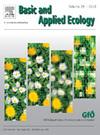温带草原土地利用强度对植物种-面积关系的影响
IF 3.5
2区 环境科学与生态学
Q2 ECOLOGY
引用次数: 0
摘要
众所周知,土地利用强度直接影响温带草原植物物种丰富度。然而,在小空间尺度上,很少研究土地利用强度对植物分布的影响,如物种-面积关系的斜率。我们考察了物种-面积关系是直接受到土地利用强度的影响,还是间接受到植物物种丰富度的影响。通过测量不同样地面积间物种丰富度的增加速率,研究了物种-面积关系。2017年或2018年,我们在德国三个地区的147个4 × 4 m的管理草地地块中分别使用了0.2 × 0.2 m和1 m × 1 m的巢式样方。利用线性模型,我们发现不同土地利用成分(刈割、放牧和施肥)对物种-面积关系有不同的直接影响。刈割降低了物种-面积关系的斜率,表明在高土地利用强度的样地内植物物种分布更为均匀。施肥对物种-面积关系的斜率影响不显著,而放牧增加了坡度。由于这些不同的成分效应,总体土地利用强度没有直接影响物种-面积关系。此外,我们利用结构方程模型评估了土地利用强度对物种-面积关系的直接和间接影响。研究发现,土地利用强度通过对物种丰富度的负向影响,对物种-面积关系只有间接负向影响。此外,通过对土地利用成分(刈割和放牧)的分析,证实了土地利用对物种-面积关系的间接负面影响。我们的研究结果强调了测试土地利用强度的直接和间接影响的重要性。此外,我们表明在能够概括土地利用对植物物种异质性的影响之前考虑区域环境差异的重要性。本文章由计算机程序翻译,如有差异,请以英文原文为准。
The effect of land-use intensity on the species-area relationship of plants within temperate grasslands
It is well-known that land-use intensity directly affects plant-species richness in temperate grasslands. However, the effect of land-use intensity on plant distribution at small spatial scales, as indicated by the slope of the species-area relationship, is rarely investigated. We tested whether the species-area relationship is directly affected by land-use intensity or indirectly via plant species richness. We studied the species-area relationship by measuring the rate of species richness increase between different plot sizes. We used nested quadrats of 0.2 by 0.2 m and 1 m by 1 m within each of 147 4 × 4 m plots of managed grasslands in three German regions in 2017 or 2018. With linear models, we found that the different components of land use (mowing, grazing and fertilization) had various direct effects on the species-area relationship. Mowing reduced the slope of the species-area relationship, indicating a more even distribution of plant species within plots at higher land-use intensity. Fertilisation did not significantly affect the slope of the species-area relationship, while grazing increased it. As a result of these different component effects, overall land-use intensity did not affect the species-area relationship directly. In addition, we used structural equation modelling to assess the direct and indirect effect of land-use intensity on the species-area relationship. We found that land-use intensity had only a negative indirect effect on the species-area relationship through a negative effect on species richness. An additional analysis with land-use components, mowing and grazing, confirmed the indirect negative effect of land-use on species-area relationship. Our results underline the importance of testing direct and indirect effects of land-use intensity. Furthermore, we show the importance of considering regional environmental differences before being able to generalize land-use effects on plant species heterogeneity.
求助全文
通过发布文献求助,成功后即可免费获取论文全文。
去求助
来源期刊

Basic and Applied Ecology
环境科学-生态学
CiteScore
6.90
自引率
5.30%
发文量
103
审稿时长
10.6 weeks
期刊介绍:
Basic and Applied Ecology provides a forum in which significant advances and ideas can be rapidly communicated to a wide audience. Basic and Applied Ecology publishes original contributions, perspectives and reviews from all areas of basic and applied ecology. Ecologists from all countries are invited to publish ecological research of international interest in its pages. There is no bias with regard to taxon or geographical area.
 求助内容:
求助内容: 应助结果提醒方式:
应助结果提醒方式:


